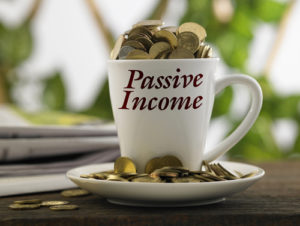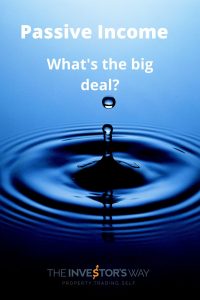What is the big deal with passive income?
It seems that the term is being used more and more often these days.
Which to me is a good thing, providing you know what it means…
…and you understand the significant benefits that passive income provides.
In the modern economy, passive income has become a crucial requirement for your money strategy.
The current employment conditions are changing so rapidly it is becoming harder and harder to rely on an ongoing salary to sustain your lifestyle…
Let alone build for your future financial self or your financial aspirations.
Now more than ever, it is important to be thinking beyond just having a job and having multiple passive income streams.
Passive Income Definition
First, so that we are all on the same page, here is a definition of passive income:
Passive income is income you derive without your direct participation.
 The idea is that you make an upfront investment of time and/or money, but once the momentum builds, there’s minimal maintenance required going forward.
The idea is that you make an upfront investment of time and/or money, but once the momentum builds, there’s minimal maintenance required going forward.
The most common types of passive income are derived from property investments, interest-bearing investments such as government bonds, term deposits or bank interest and corporate dividends from holding stocks.
Passive income investments aren’t just for later, for retirement, or the extremely long term.
Passive income changes the dynamics of your income and expenses.
Generating additional income now from your passive investments can turn the tide in your favour when you are trying to balance your income and expenses each month.
It can help you find the money to both pay the bills and live a little.
Cash flow is the key to overcoming money stress and achieving financial freedom.
The cash flow from your passive income investments is what will enable you over time to effectively buy back your time. Now that’s sounding exciting, right?
Income When You Can’t Work
Most accept that there will come a day when they will need to retire.
At that point, passive income is a must for covering living expenses.
Particularly as Government’s find it harder and harder to provide for an ageing population that is living longer.
Yet, we never really know how soon that day will come.
Almost 70 per cent of the U.S. population stops working by the time they are 65 years old. In Australia 65 is currently the age in which retirement savings become available from your superannuation account.
Many retire much earlier, which may become more popular as technology replaces more and more jobs.
At some point, all of us will probably need time off work due to health issues, injuries, or family emergencies.
How will you keep the money coming in during these unforeseen periods?
 Passive income opportunities can close that gap and provide cash flow while you are sleeping. It is in fact the first step in defining wealthy.
Passive income opportunities can close that gap and provide cash flow while you are sleeping. It is in fact the first step in defining wealthy.
Freedom
Life is short…
Studying and working for 65 years in the hopes of surviving in retirement doesn’t make for much of a life.
Unfortunately, most people have less than they need in their savings when retirement rolls around.
It is very difficult to retire and live comfortably with limited access to cash.
Passive income provides the means by which you’ll be able to live, travel, and spend your time wherever you like, doing what you like with whom you like.
So let’s look a little closer at some of the more popular passive income investments used by active investors.
The Top 4 Passive Income Examples
In no particular order, here are 4 of the most common and successful investments for generating passive income.
1. Real Estate
Despite some ups and downs in recent years, real estate continues to be a preferred choice for investors who want to generate long-term returns.
 Investing in a rental property, for example, is one way to produce a regular source of income.
Investing in a rental property, for example, is one way to produce a regular source of income.
At the outset, an investor may be required to put up a 20% down payment to buy the property, but that may not be a barrier for someone who’s already saving regularly.
Once reliable tenants are installed, there’s very little left to do except wait for the rent money to begin rolling in.
Real estate investment trusts (REITs) are another passive investment option for investors who aren’t interested in dealing with the day-to-day responsibility of managing a property.
One of the main advantages of a REIT is that they payout 90% of their taxable income as dividends to investors.
There is a downside, however, since dividends are taxed as ordinary income. That may be problematic for an investor who’s in a higher tax bracket.
2. Peer-to-Peer Lending
The peer-to-peer lending (P2P) industry is just over a decade old, and the market has grown by leaps and bounds.
For investors who want to help others while adding passive income to their portfolio, peer-to-peer lending is an attractive choice.
One advantage is there are fewer barriers to entry compared to other types of investments.
For example, both Prosper and Lending Club, two of the largest P2P platforms, allow investors to fund loans with as little as a $25 investment.
In terms of the returns, peer-to-peer lending can be profitable, particularly for investors who are willing to take on more risk.
Loans pay a certain amount of interest to investors, with the highest rates associated with borrowers who are deemed the biggest credit risk.
Returns typically range from 5% to 12% per annum, and there’s very little the investor has to do beyond funding the loan.
3. Dividend-Paying Stocks
Dividend-paying stocks are one of the easiest ways for investors to create passive income because you’re effectively getting paid to own them.
 As the company brings in earnings, part of the earnings is returned to investors as a dividend.
As the company brings in earnings, part of the earnings is returned to investors as a dividend.
This money can be reinvested to purchase additional shares or received as a cash payment.
Dividend yields can vary greatly from one company to the next, and they can also fluctuate from year to year.
Investors who are unsure about which dividend-paying stocks to choose should stick to ones that have a history of paying dividends, and particularly a history of increasing the amount of the dividend year on year.
4. Index Funds
Index funds are mutual funds that are tied to a particular market index.
These funds are designed to mirror the performance of the underlying index they track, the most popular of these funds presently are Exchange Traded Funds or ETF’s.
Index funds are passively managed, and the securities included in them don’t change unless the composition of the index changes.
For investors, this translates to lower management costs.
ETF’s are one of the fastest-growing products in the financial markets and represent an excellent way to get started in the stock market…
And the variety of options available is extensive, meaning you can invest in almost any stock index from around the world.
Conclusion
Passive income investments can make an investor’s life easier in many ways, particularly when a hands-off approach is preferred.
The four options outlined here represent differing levels of diversification and risk.
As with any investment, it’s important to weigh the anticipated returns associated with a passive income opportunity against the potential for loss.
As you progress it is wise to have some of your investment money in each of these forms of investment…
That way you manage your risk and get exposure to each of the markets, which will perform at different rates depending on the economic cycle.
Leave a comment below to let me know what passive investments you prefer, especially if you have any additional ideas.
Ready to Grow Your Passive Income Streams
Claim your free brainstorming session with Andrew to start creating a plan for a 7 figure net worth
Click here to claim your session now

